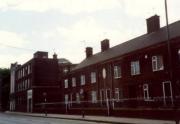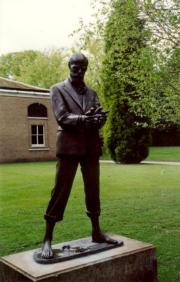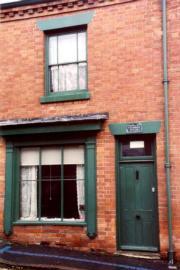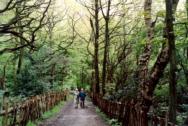2003
WEDNESDAY 30th APRIL
Discovering my roots in Nottingham10.32pm. In bed at Ron Faulk’s bungalow, 24 Briarwood Avenue, Nottingham, where we arrived about 5.20pm yesterday. We spent nearly three hours with the family [at Solihull, where we saw Clarice’s new house] on the way up. A remarkable day. Ron drove us no great distance to Westminster Close, on the site of Westminster Street where Dad was born [on 27 February 1907] at 1 Franchise Terrace. The streets and terraces, still here when I used to preach at Hungerhill Road, were all swept away in the late 1960s, but Cromer Street, next street along, still remains, relatively unspoiled. As a toddler Dad must many times have been up this road and round about. We walked up and down Hungerhill Road, of which nothing remains: there is no hint of where the church used to be, but perhaps we have a colour slide. [No! — slide 01308, photographed on Saturday 12 October 1963, is of a different church, on the corner of Bathley Street and Lamcote Grove.] From there, Ron drove us to St Matthias’ Church, Sneinton, where my great-grandparents Edward Henry and Mary Elizabeth Barker were married on 9th April 1882, and Walker Street where they lived. He was manager of a box warehouse. Although all the old buildings have gone, the street remains. Next we visited Sneinton Parish Church of St Stephen and St Alban and saw the gravestone of Ron’s grandparents. From there we walked to the birthplace, now a museum, of General William Booth, where we were most cordially received and refreshed with coffee and biscuits. I saw the name of Cyril Barnes, whom I knew personally. Across the road from where we parked the car (Ron’s) was the Congregation of Yahweh, which I recognised as Peter Warsop’s church. I wonder if he and Joyce are still alive? I should love to see them again. I feel not the slightest ill-will towards Peter, though he was my Alexander the Coppersmith. After this Ron drove us to John Lewis’s, parking beneath the store in what used to be the LNER station and is now the largest underground car park in Europe. I treated us to lunch of carrot and orange soup and roll and butter, followed by pancakes and fruit and ice cream, £13.25, a bit expensive for us but a pleasant meal. Finally Ron took us to the Local Studies building where I had a not very productive time trying to trace the occupants of 82 Coalpit Lane where Grandad [Ernest Alfred Williams] was born on 11 October 1882. Oddly, the 1881 Census shows a George Williams (69), Ann (37) and Arthur (11) living there, whom I have never heard of. So who are they? This evening we have been talking about Bert Lawrence. Ron read from Sons and Lovers about “Aggie Bower” being asked for as midwife at Paul’s birth. I have been perusing Jane Maskrey’s doctoral thesis from 25-30 years ago, of the characters in Lawrence’s stories and their real identity. In Delilah and Mr Bircumshaw (1911-12) Ethel & Henry Bircumshaw appear, and Miriam B. was a neighbour of the Lawrences at Lynncroft. In The Miner at Home Mr Bower is based on Lawrence’s father, Gertie Bower (Gertrude in Sons and Lovers) is based on his mother, and Jack Bower may represent himself as a child. |
THURSDAY 1st MAY
FRIDAY 2nd MAY
Previous chapter || Next chapter || Index || Search



